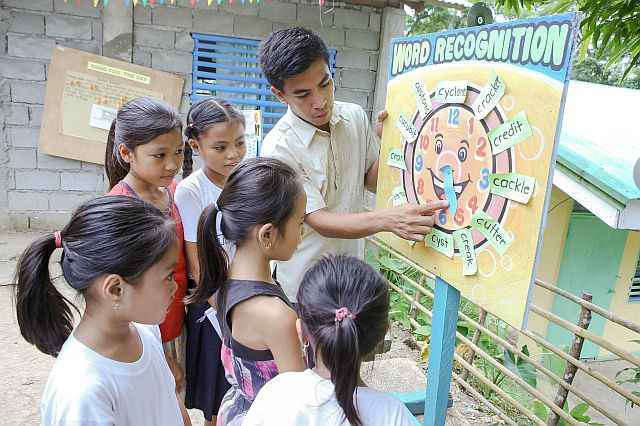
Ryan Homan reaches out to children in far-flung barangays in Donsol, Sorsogon and teaches them to read.
LAST OF FIVE PARTS
On board his balsa (raft) with a plastic box full of books and school supplies, public school teacher Ryan Homan reaches far-flung communities in the mountainous areas of Donsol, Sorsogon, to spread the joy of reading.
Homan, 30, crosses rivers to reach children in the neighboring villages and teach them to read and write using interactive games and colorful visual aids.
He carries out this advocacy work on weekends, outside of his job as an elementary school teacher in San Jose Elementary School.
“It is my social responsibility to share my blessings to the children because I was like them. Coming from a poor family, I know how it feels to have no access to reading materials,” he said.
His passion and advocacy for reading earned for Homan a place in the 2016 roster of honorees of an advocacy campaign, The Many Faces of the Teacher (TMFT), run bv Bato Balani Foundation Inc. and Diwa Learning Systems.
Homan was among four teachers chosen from 12 finalists of the TMFT search, who were honored on Oct. 1 at the Waterfront Cebu City Hotel and Casino as part of the celebration of the Teachers’ Day on Oct. 5.
Roots
The eldest among six siblings, Homan grew up in a family where eating a full meal once a day is considered a luxury.
The remote village of San Jose, where he was born and raised, is located 20 kilometers from the town center of Donsol, so access to reading materials was hard to come by.
The future seemed bleak for Homan to go to college and fulfill his dreams of becoming a teacher.
“I became an SK (Sangguniang Kabataan) chairman, which gave me the opportunity to apply for a scholarship and reach my dreams,” said Homan.
He left home and settled in Legazpi City for four years until he finished his education degree in 2006.
In 2008, he passed the Licensure Examination for Teachers and decided to go home and serve his village.
There was, however, no vacancy in San Jose Elementary School, so he went to another remote village, Barangay Old Maguisa, which did not have any school and volunteered to serve as a teacher without any salary.
In Old Maguisa, Homan first became a teacher to 20 children, with ages ranging from five to 10 years old.
He divided the class according to ability – fast, moderate and slow – and taught them to read and write.
In 2009, the Department of Education formally opened the school and sent another teacher, a young lady named Maria Maricel, to be his companion.
Not long enough, Maria Maricel became his girlfriend and then his wife.
Creativity
After five years of serving in Old Maguisa, the couple was transferred to San Jose Elementary School as Maricel was already pregnant with their first child.
In his alma mater, Homan went full force in building a reading culture by starting a reading garden and setting home-based reading centers.
He solicited help from barangay officials and nongovernment organizations such as Educo Philippines, which provided books and other reading materials.
This was also made possible by the active involvement of the Parents-Teachers Association.
Realizing that he needs help in spreading the advocacy, Homan trained housewives how to read and serve as teachers to their children.
“Called nanay-teachers, the mothers attend training seminars with me at least once a year so they learn how to teach reading to their children,” said Homan.
Interactive word games and colorful visual aids characterize the reading garden and home-based reading centers in Barangay San Jose.
He holds a storytelling session after the students eat their lunch.
It is not unusual for the school to have reading parties to engage grade school pupils in a mini-theatre show or the kindergarten pupils for a puppet show.
Volunteers
To encourage volunteerism among the younger generation, Homan started a group called Kabataan para sa Karunungan at Kalikasan.
He has trained 25 “little teachers” to help in other literacy initiatives such as the Walk for Knowledge, where he personally visits the children in their houses to teach them to read and write.
His wife and two children — Rhian Phoem, 5, and Alleyah Faith, 4 — are also active in his advocacy.
Homan also started a roving library out of a wooden pushcart which he uses to go around the community after school hours to bring reading materials to children.
“It was not an easy crusade because as the first person to finish a college degree in our village, I was viewed as privileged, but here I was pushing a cart. It was considered unbecoming of a teacher,” he said.
But Homan pressed on.
Slowly, children and parents saw his dedication and commitment, and they became cooperative in his literacy initiatives.
Future
Homan said he is fortunate to have become a recipient of various professional enrichment programs including a training on multi-grade teaching at the University of the Philippines.
When the children have read all the books in reading garden and reading centers, Homan started writing and illustrating his own storybooks in their mother tongue. Moving forward, he wants other villages to have home-based reading centers and for schools to have reading gardens.
“I hope to be an inspiration to these children so they too will become successful in whatever field they would choose to be in,” he said.